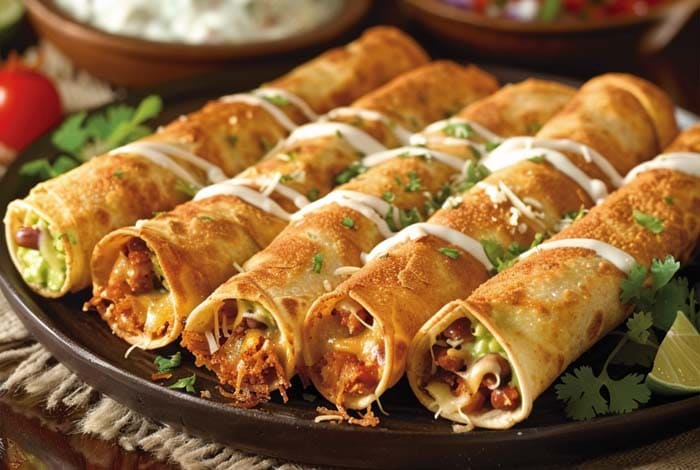Introduction to Flautas
Flautas, a staple in Mexican cuisine, are often likened to a musical instrument from which they draw their name, the flute, due to their long, rolled shape. These crispy rolled tacos are fried to a golden hue, encapsulating a variety of fillings, most commonly shredded chicken or beef. The dish’s simplicity belies its rich taste and texture, making it a popular choice across Mexico and extending into South Texas. The debate over flautas versus taquitos is notable, with distinctions largely hinging on regional preferences in naming and minor differences in preparation. Some argue that the use of flour or corn tortillas is the dividing line, with flautas typically rolled in flour tortillas and taquitos in corn, although this can vary by region and personal tradition.
Origins and Cultural Significance
The origins of flautas are subject to debate, with various regions in Mexico laying claim to the dish. The state of Sinaloa is often mentioned in discussions about the dish’s roots, symbolizing the regional pride and cultural significance that flautas carry within Mexican culinary traditions. This regional diversity is a hallmark of Mexican cuisine, with different areas adapting the basic flauta to local tastes and available ingredients. As flautas traversed borders into the United States, they took on new forms, reflecting the adaptability and appeal of Mexican food culture abroad. In both traditional and modern contexts, flautas hold a revered spot, serving not only as a beloved meal but also as a cultural bridge, linking the culinary heritage of Mexico with the broader tapestry of global cuisine. The adoption and adaptation of flautas in American food culture, especially in areas with significant Mexican communities like South Texas, underscore the dish’s ability to transcend cultural boundaries, blending traditions to create new culinary expressions that are cherished by a wide audience.
These insights into flautas not only showcase the dish’s deep-rooted history in Mexican cuisine but also highlight its role in the evolving landscape of international food culture, where traditional recipes are embraced and reimagined across borders.
Flautas vs. Taquitos: Understanding the Differences
In the culinary tapestry of Mexican cuisine, flautas and taquitos often spark a flavorful debate, primarily centered around tortilla type, size, and regional preferences. Traditionally, flautas are made with flour tortillas, lending them a slightly softer texture and a larger size, while taquitos typically employ corn tortillas, known for their crispiness and smaller stature. This distinction, however, isn’t universal; regional variations and personal preferences can blur these lines, with some areas in Mexico and the United States using the terms interchangeably or favoring one type of tortilla over the other regardless of the dish’s name.
Culinary experts highlight that beyond the base ingredient of the tortilla, the preparation method plays a crucial role in differentiating these dishes. Flautas, owing to their larger size and flour-based tortilla, are often filled more generously and served as a main dish. Taquitos, on the other hand, given their smaller size and corn tortilla composition, are frequently enjoyed as appetizers or snacks
The debate between flautas and taquitos illustrates the rich diversity within Mexican cuisine and its adaptations beyond Mexico’s borders. While the distinctions may seem subtle to the untrained palate, they reflect deeper regional and cultural nuances that enrich the culinary landscape. Understanding these differences not only enhances appreciation for Mexican cuisine but also offers insight into how traditional dishes evolve and adapt over time and across geographies.
How to Make Flautas: A Step-by-Step Guide
Making chicken flautas begins with preparing the filling, which typically involves cooking and shredding chicken. Seasonings such as salt, pepper, cumin, and sometimes chili powder are added to infuse the chicken with flavor. The shredded chicken is then wrapped tightly in tortillas, which can be either flour or corn based on preference or regional tradition. To prevent cracking and to ensure flexibility, the tortillas may be warmed slightly before filling and rolling.
The rolling process is critical: the tortilla should be snug around the filling to prevent it from falling out during frying. Securing the roll with toothpicks can help maintain its shape. The flautas are then fried in hot oil until they achieve a golden and crispy exterior. This process not only cooks the flauta but also seals in the filling, creating a delightful texture contrast between the crunchy exterior and the tender interior.
For variations, the filling can easily be swapped out for beef or pork, following a similar preparation process. Vegetarian options abound, with fillings such as mashed potatoes mixed with cheese and spices, or a combination of sautéed vegetables. These alternatives provide a wonderful way to customize flautas to dietary preferences or simply to enjoy a variety of flavors.
Serving and Pairing Flautas
Serving flautas is an opportunity to get creative with toppings and sides. Traditional garnishes include shredded lettuce, diced tomatoes, sliced avocados, and a dollop of sour cream. Queso fresco or cotija cheese can add a savory note, while a sprinkle of chopped cilantro brings freshness. Flautas are often served with a side of salsa for dipping, ranging from mild tomato-based salsas to spicier versions made with chilies like serrano or jalapeño.
Pairing flautas with drinks is another aspect where tradition meets personal preference. A refreshing agua fresca, such as tamarind or hibiscus, complements the richness of the flautas. For those preferring something with a bit more kick, a classic margarita or a cold beer can balance the flavors perfectly.
Innovative serving suggestions include flautas ahogadas, where the flautas are drenched in a savory sauce, often green or red salsa, and then topped with cream and cheese. This method adds moisture and an extra layer of flavor, making each bite a delightful mix of textures and tastes.
Through these serving and pairing suggestions, flautas can be enjoyed in a myriad of ways, each offering a unique glimpse into the versatile and vibrant world of Mexican cuisine.
Storing and Making Ahead
To ensure flautas maintain their crispiness when stored, it’s best to let them cool down completely before storing them in an airtight container. If you have leftovers, refrigerating them can keep them fresh for up to three days. For reheating, using an oven or air fryer can help recrisp the exterior while keeping the interior moist. This method is preferable to microwaving, which can make the tortillas soggy.
Making flautas ahead of time is feasible and practical. You can prepare and refrigerate the filling up to two days in advance. Fully assembled flautas can be tightly wrapped and stored in the refrigerator for a day before frying, or frozen if you plan to cook them more than a day later. When ready to cook, flautas can go directly from freezer to fryer, adding only a minute or two to the frying time.
FAQs
- Best oil for frying: For frying flautas, high smoke point oils like vegetable, canola, or peanut oil are recommended. These oils ensure that the flautas can be fried at the right temperature without burning.
- Preventing flautas from unrolling during frying: Securing the flautas with toothpicks after rolling them is a common practice. Ensure the toothpicks are inserted in a way that they can be easily removed after frying.
- Differences in taste with different fillings: The choice of filling greatly influences the taste profile of flautas. Chicken offers a lighter, subtler flavor that’s well complemented by various toppings and sauces. Beef provides a richer, more robust taste, ideal for those seeking a hearty meal. Pork, often seasoned with more pronounced spices, offers a tender and flavorful option. Vegetarian fillings, like mashed potatoes or beans, can offer a delightful contrast of flavors and textures, especially when paired with the right spices and cheese.
Incorporating these practices and understanding these common inquiries can elevate your flautas-making experience, ensuring delicious results every time.

Flautas Recipe
Equipment
- Frying pan or deep fryer
- Mixing bowls
- Toothpicks (optional for securing)
- Tongs
Ingredients
- 2 cups shredded chicken or your choice of filling
- 12 small flour or corn tortillas
- 1 cup vegetable oil for frying
- Salt and pepper to taste
- Optional garnishes: lettuce sour cream, cheese, salsa
Instructions
- Prepare the filling by seasoning your chosen protein or vegetables.
- Warm tortillas to make them pliable.
- Place a portion of the filling on each tortilla and roll tightly.
- Secure with toothpicks if necessary.
- Fry in hot oil until golden and crispy.
- Drain on paper towels and serve with your favorite toppings.
Notes
- For a healthier version, flautas can be baked at 400°F (200°C) for about 20 minutes or until crispy, turning once.
- Experiment with fillings and toppings based on preferences.
- Leftover flautas can be reheated in an oven or air fryer for best results.

